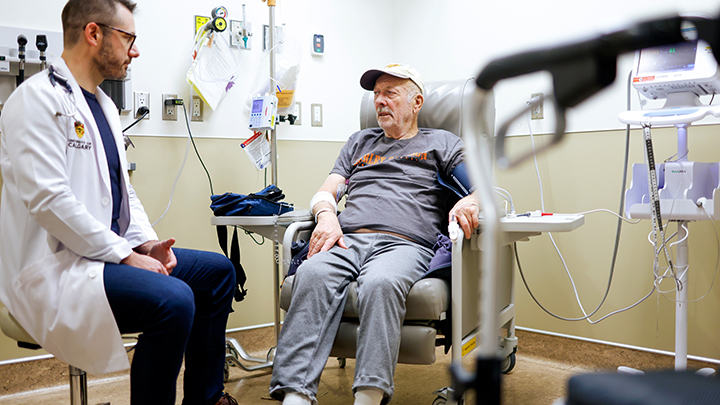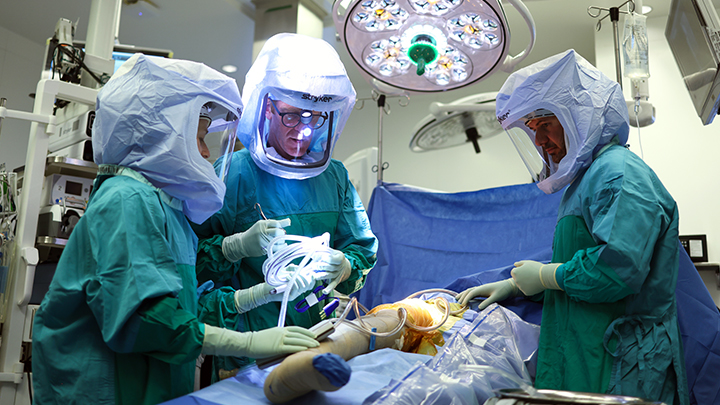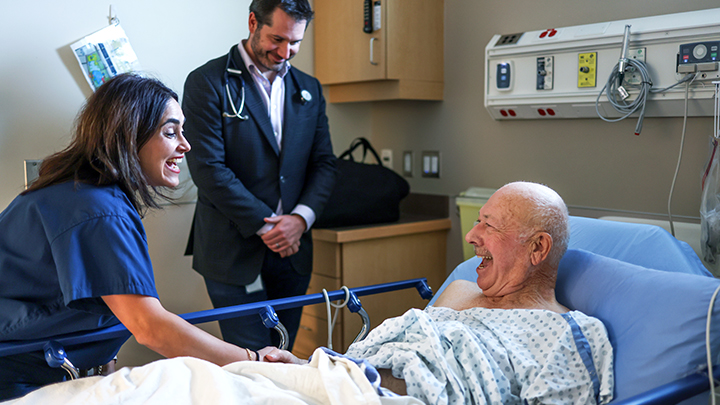
December 12, 2024

Infectious diseases physician Dr. Stephen Vaughan cares for patient Boyd English, who’s receiving a bacteriophage infusion days after his surgery. English has a prosthetic hip joint that keeps getting reinfected. Bacteriophage therapy, which has been used just a few times in Canada, uses viruses to infect and destroy bacteria. Photo by Leah Hennel.

The surgical team examines an image of the artificial hip of Boyd English, who underwent a procedure that introduced bacteriophages to the infected area, followed by twice-daily intravenous phage infusions for 14 days. Photo by Leah Hennel.

Nancy Tawil, CEO of Qeen Biotechnologies, left, and infectious diseases physician Dr. Stephen Vaughan enjoy a lighter moment with their patient Boyd English. Photo by Leah Hennel.
Story by Greg Harris | Photos by Leah Hennel
CALGARY — With a recurring infection in his prosthetic hip joint, 75-year-old Boyd English has come to appreciate just getting through a day without pain keeping him mostly in bed.
“I’m down to about 1,600 steps a day,” the Calgary-area man says. “It hasn’t been much of a life for about a year now.”
English’s situation appears to be improving, however, since he became the first in Western Canada to have an antimicrobial-resistant infection in his prosthetic hip joint treated with bacteriophages — using viruses to kill bacteria.
He underwent a surgical procedure on Nov. 20 that introduced the bacteriophages to the infected area, followed by twice-daily intravenous phage infusions for 14 days.
Dr. Stephen Vaughan, an Alberta Health Services infectious diseases specialist and University of Calgary clinical associate professor, obtained Health Canada approval for the experimental treatment, which was administered as part of a research study.
“This is, in effect, a Hail Mary attempt to save Mr. English’s leg,” says Dr. Vaughan. “We're cautiously optimistic this will cure the infection and provide some enduring improvement in his quality of life.”
(Editor’s note, June 2025: Since undergoing bacteriophage therapy, English has continued to progress and reports less pain, better sleep and improved mobility. “It’s unbelievable how much this unique treatment has improved my life,” he says. Dr. Vaughan notes: “We are past the six-month mark and there is no sign of infection. All tests indicate the infection has been eradicated.”)
While antibiotics act like a blanket neutralizer on bacteria, bacteriophages are more like assassins that target specific bacteria. They infect those bacteria, then replicate until the bacteria burst, amplifying the benefit at the site of infection while leaving other cells unharmed.
English broke his hip while working in the Yukon in 1973. Following a hip replacement, he didn’t experience any issues until 2013 when he had to have another surgery as a result of a ranching injury. A rare post-operative complication of that surgery resulted in the persistent infection.
He has since undergone multiple surgeries to have the dead and infected tissue cleared away and the site “washed out” with antibiotics, but these efforts have proved only temporarily successful. And due to the amount of hardware in his body that can’t be removed, curing his infection is nearly impossible. Bacteria stick to hardware like a slime.
Despite courses of intravenous and oral antibiotics following each surgery, the infection has returned. The concern is — a time will come when English could face amputation — or worse, a more severe infection that could lead to death.
“Boyd has been a patient of mine for 11 years now,” adds Dr. Vaughan, “and since that time, he’s had nine washout surgeries, which is unheard of. We had to try something new.”
Dr. Vaughan reviewed the medical literature and consulted with other clinician-scientists around the world who are working with bacteriophages, including Dr. Greg German in Toronto. He was referred to Qeen Biotechnologies, a Canadian company that isolates and specially formulates a treatment of bacteriophages based on samples of a patient’s specific infection.
“We are excited to contribute to this groundbreaking study,” says Nancy Tawil, CEO of Qeen Biotechnologies. “Our extensive library of bacteriophages enables us to precisely screen for specific infections and develop customized therapeutic blends with the potential to deliver highly effective, targeted treatments.”
Bacteriophage therapy was studied long before the development of antibiotics, but then largely abandoned when antibiotics proved so effective. Now, with the growth of anti-microbial resistance, bacteriophage therapy has reemerged as a promising alternative.
Dr. Vaughan says, to his knowledge, only a handful of patients in Canada have received bacteriophage therapy, including an Ottawa patient who had an infection similar to English’s. A large-scale trial is currently underway at the Mayo Clinic in the U.S.
For his part, English will gratefully take whatever improvements he can get out of the treatment.
“When you go through what I’ve gone through in the last 11 years, anything’s better and it’s a hope, right?”
Anyone interested in supporting phage therapy research can make a donation here.